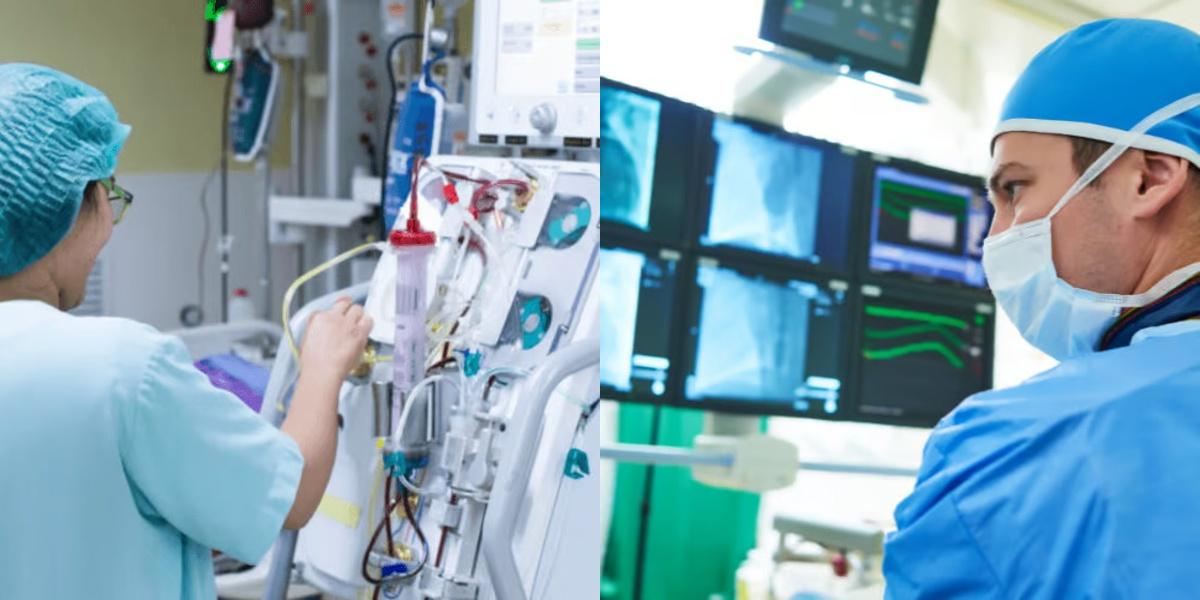Hemodialysis Technician vs Radiology Technician

Want personalized recommendations?
Let's match you to the right program

When it comes to vocational training, there are many options to choose from. Two popular choices in the healthcare field are hemodialysis technician and radiology technician. Both careers offer rewarding opportunities to work with patients and make a difference in their lives. In this blog post, we will explore the differences between these two professions and provide insights into their job descriptions, education and training requirements, as well as career outlook and salary expectations.
Article continues after recommendations
Recommended for you
What is a Hemodialysis Technician and Radiology Technician?
Hemodialysis Technician: A hemodialysis technician, also known as a dialysis technician, is responsible for operating and maintaining dialysis equipment. They work closely with patients who have kidney failure and require regular dialysis treatments to remove waste and excess fluid from their blood. Hemodialysis technicians are trained to monitor patients during treatment, ensure the proper functioning of the dialysis machine, and assess any potential complications.
Radiology Technician: A radiology technician, also referred to as a radiologic technologist or radiographer, performs diagnostic imaging examinations, such as X-rays, CT scans, and MRIs. They work closely with radiologists and other healthcare professionals to capture images of a patient's internal structures for diagnostic purposes. Radiology technicians are responsible for positioning patients, operating imaging equipment, and ensuring the quality and accuracy of the images produced.
Difference between a Hemodialysis Technician and Radiology Technician
While both hemodialysis technicians and radiology technicians work in the healthcare field, there are several key differences between these two professions. Here are some of the main distinctions:
-
Job Focus: Hemodialysis technicians primarily focus on providing direct care to patients with kidney failure who require dialysis treatments. They are responsible for operating dialysis machines, monitoring patients, and addressing any complications that may arise during treatment. On the other hand, radiology technicians focus on capturing diagnostic images of patients using various imaging techniques. They work with a wider range of patients and conditions, performing imaging examinations that help doctors diagnose and treat medical conditions.
-
Working Environment: Hemodialysis technicians often work in dialysis centers or hospitals' dialysis units. These settings are specifically designed to provide dialysis treatments to patients. Radiology technicians, on the other hand, work in a variety of healthcare settings, including hospitals, clinics, and imaging centers. They may also have the opportunity to work in specialized areas such as interventional radiology or nuclear medicine.
-
Patient Interaction: Hemodialysis technicians have frequent and direct contact with patients as they provide hands-on care during dialysis treatments. They build relationships with patients, monitor their vital signs, and ensure their comfort and safety throughout the procedure. In contrast, radiology technicians have limited direct contact with patients. They primarily focus on capturing high-quality images and working closely with radiologists to interpret these images. While they may interact briefly with patients during the imaging process, their role is more focused on technical expertise.
Hemodialysis Technician vs Radiology Technician: Job Description
Hemodialysis Technician:
- Operate and maintain dialysis machines
- Prepare patients for dialysis treatments
- Monitor vital signs and assess patient response to treatment
- Administer local anesthesia and vascular access procedures
- Educate patients on self-care techniques and lifestyle changes
- Collaborate with healthcare professionals to coordinate patient care
Radiology Technician:
- Position patients for imaging procedures
- Operate imaging equipment, such as X-ray machines or CT scanners
- Follow protocols to capture high-quality images
- Ensure patient safety during procedures
- Assist radiologists in interpreting images
- Maintain accurate patient records and documentation
Hemodialysis Technician vs Radiology Technician: Education and Training
Hemodialysis Technician:
- Education: Most hemodialysis technicians complete a vocational training program in dialysis technology or a related field. These programs typically last 6 months to 1 year and include both classroom instruction and hands-on clinical experience. Some states may also require certification or licensure to practice as a hemodialysis technician.
- Training: Hemodialysis technicians receive extensive on-the-job training to become familiar with the dialysis equipment and procedures specific to their workplace. They may also receive additional training on infection control, patient safety, and emergency protocols.
Radiology Technician:
- Education: Radiology technicians typically need to complete an associate's degree in radiologic technology. These programs usually take 2 years to complete and include coursework in anatomy, patient care, radiation physics, and medical imaging. Some states may require radiology technicians to be licensed or certified.
- Training: Radiology technicians receive hands-on training during their clinical rotations, where they work under the supervision of experienced technologists. This training allows them to gain practical experience in performing imaging procedures and working with patients.
Get courses selected just for you
Try our powerful search engine
Article continues after recommendations
Hemodialysis Technician vs Radiology Technician: Career Outlook and Salary
Hemodialysis Technician:
- Career Outlook: The demand for hemodialysis technicians is expected to grow due to the increasing prevalence of kidney disease and the aging population. As more people require dialysis treatments, there will be a need for trained professionals to operate and maintain dialysis machines. Job opportunities for hemodialysis technicians can be found in dialysis centers, hospitals, and other healthcare facilities.
- Salary: The median annual wage for hemodialysis technicians is around $40,870, according to the Bureau of Labor Statistics. The salary can vary depending on factors such as experience, location, and the type of healthcare facility.
Radiology Technician:
- Career Outlook: The job outlook for radiology technicians is also promising, with a projected growth rate of 7% from 2019 to 2029. This growth is attributed to the increasing demand for diagnostic imaging and the need for skilled technicians to perform these procedures. Radiology technicians can find employment in hospitals, clinics, imaging centers, and other healthcare settings.
- Salary: The median annual wage for radiologic technologists is approximately $62,280, according to the Bureau of Labor Statistics. The salary can vary depending on factors such as education, experience, location, and the type of healthcare facility.
Final Thoughts
Both hemodialysis technicians and radiology technicians play vital roles in the healthcare field. While hemodialysis technicians focus on providing direct care to patients with kidney failure, radiology technicians capture diagnostic images that help doctors diagnose and treat various medical conditions. The choice between these two professions ultimately depends on individual interests, career goals, and the desire to work closely with patients or focus on technical expertise. Regardless of the path chosen, vocational training in either field can lead to a fulfilling and rewarding career in healthcare.
Dreambound extends its programs to diverse locations. Delve deeper into information about these two vocations by visiting:

Blessed Joy Amarga is part of the Growth and Sales teams at Dreambound. She helps bring in new leads, increasing the number of people at the top of the sales funnel, and supporting the team in creating graphics to boost social media engagement. Blessed is also a Licensed Architect. Outside work, she enjoys traveling and exploring new places for her vlog.



